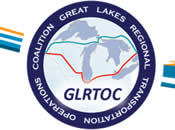Coordination of Projects in the Great Lakes Region

The Great Lakes Regional Transportation Operations Coalition (GLRTOC) was founded in 2009 with the mission to improve cross-regional transportation operations in support of regional economic competitiveness and improved quality of life. The member agencies extend from Minnesota through Wisconsin, Illinois, Indiana, Michigan, and Ontario. To date, this has been a volunteer effort with only donated resources. Early in the coalition's efforts, two demonstration corridors were identified, representing the approximately 1,000-mile trip between Minneapolis on the west and Toronto on the east. The southern route (I-94, Highway 401, and associated routes) emphasizes work zone coordination and metropolitan issues, while the northern route (US 2, Highway 17-400, and associated routes) emphasizes winter operations and rural issues.
Key elements of their work zone efforts are an annual work zone preview, an online map, and corridor performance monitoring. In 2012, GLRTOC was awarded funds through the USDOT Multi-State Corridor Operations and Management to improve center-to-center communications and expand traveler information services across the region, and for additional work zone collaboration, coordination, and monitoring. The work zone effort entails: 1) resource support for the annual work zone preview; 2) major changes to the work zone mapping application; and 3) multiagency work zone performance monitoring.
Annual Work Zone Preview: Each year GLRTOC member agencies meet to discuss their upcoming road projects to increase awareness of neighboring work zones and to identify opportunities for adjustments or remediation.
Online Map: GLRTOC provides an online work zone map, displaying all planned work zones in the region. This map is developed by collecting information from all member agencies in whatever format they already had it available and then creating the map using manual processes and ArcGIS. GLRTOC is enhancing the map to provide for multi-user, authenticated editing where users who are logged in across any agency will be able to modify, add, or remove work zones throughout the year. In addition, users from the general public will be able to search, query or extract work zone information directly from the online map interface.
Corridor Performance Monitoring and Traveler Information: GLRTOC is working to improve multi-agency work zone performance monitoring via a pilot test on the I-39/90 segment between Madison, WI and Rockford, IL. This 65-mile segment is mostly rural and has little or no traffic detection, but is a key recreational and freight corridor maintained by three different agencies: Wisconsin DOT, Illinois DOT, and Illinois Tollway. Each has major work zones within a 4-year span, primarily as they expand the road from a four-lane interstate to a six-lane interstate, and sometimes these work zones happen simultaneously across borders. GLRTOC is working on additional traffic detection on this corridor, primarily with Bluetooth, and integrating this data into the Regional Gateway Traveler Information System and potentially to other operations centers to make the information available to operators across State borders. The information, such as travel times, will also be available to the public via Web, phone, and dynamic messages, and archived for researchers.
- Great Lakes Regional Transportation Operations Coalition Work Zones Web Page
- GLRTOC Work Zones Map
- Presentation on GLRTOC's Work Zone Coordination Efforts - from September 2012 Work Zone Project Coordination webinar
